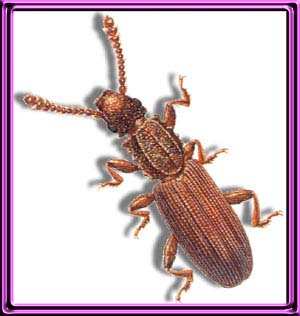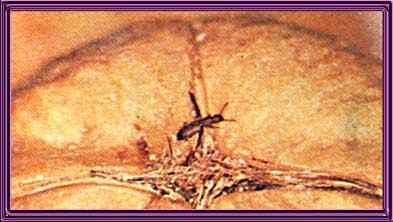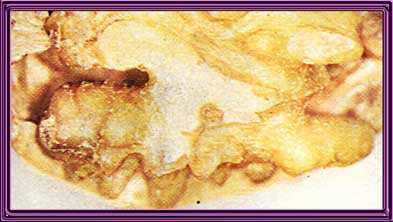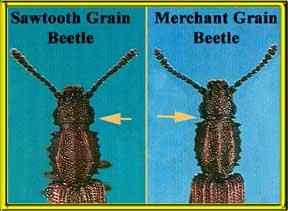
(Saw-toothed Grain Beetle)
(Merchant Grain Beetle)
But you can't do that I hear everyone cry..He's got two names and only one picture..Damn right, because the differences between the two insects are very small and it takes someone with experience to be able to differentiate between them. However, when I have finished you'll all be able to do it...identify them I mean..!The adults of both species, can be distinguished by head shape, eye and body size, and colour. In the merchant grain beetle the eye diameter is larger than the temple region behind the eye, and the head is rectangular. The sawtoothed grain beetle, in contrast, has smaller eyes and a more triangular shaped head. The merchant grain beetle is somewhat larger and darker brown. Because both species are approximately 1/10 inch long, the larger size of the merchant grain beetle is difficult to assess in the grain bin. The most descriptive characteristic of both species is the six saw-like teeth found on either edge of the pronotum.
The habits and development of the two species are similar. The merchant grain beetle, however, is less cold tolerant and lays only about one-half to two-thirds as many eggs as does the sawtoothed grain beetle. The adult merchant grain beetles are strong fliers and may originate from other areas; they also are introduced into new grain from contaminated grain. The adults of the sawtoothed grain beetle, on the other hand, cannot fly and must be introduced from contaminated grain. An added help in identification is that the merchant grain beetle tends to prefer food sources which are higher in oil content such as nuts or copra.
Both sawtoothed and merchant grain beetles are common stored-food product pests that infest cereals, cornmeal, cornstarch, popcorn, rice, dried fruits, breakfast foods, flour, rolled oats, bran, macaroni, sugar, drugs, spices, herbs, candy, dried meats, chocolate, bread, nuts, crackers, raisins, dried dog and cat food, and other foodstuffs, making them unsalable and unpalatable. These beetles are capable of chewing into unopened paper or cardboard boxes, through cellophane, plastic, and foil wrapped packages. Once inside, populations build up rapidly often spreading to other stored foods and into food debris accumulated in the cupboard corners, cracks, and crevices. Sometimes all life stages (egg, larva, pupa, and adult) may be found. These insects contaminate more food than they consume, and usually are discovered leaving the infested food to crawl about the house. Adults and larvae are external feeders, feeding on finely divided food particles and not whole grains. The insects have running legs (ambulatory) much like cockroaches and penetrate "tightly sealed" packaging.
Lifecycle:
Both beetles lay eggs singly or in small batches in the food material where the life cycle is completed. The sawtoothed grain beetle cannot fly, but the merchant grain beetle can fly. Adults usually live about 6 to 10 months, with some living as long as 3 years and 3 months. Female sawtoothed grain beetles usually emerge in April and lay an average of 300 eggs. Egg laying begins about 5 days after emergence and continues up to 3 to 4 weeks. Eggs hatch in about 8 days, larvae mature in 37 days, and pupa about 67 days. The life cycle can be completed in 51 days or as early as 27 to 35 days depending on temperature. Merchant grain beetles lay an average of 200 eggs over 28 to 42 days, requiring about 35 days to complete the life cycle. There may be as many as 6 to 7 generations under warm conditions of 85°F to 95°F and 70% relative humidity, with fewer generations throughout the winter months. Adults remain active and feed. The sawtoothed grain beetle prefers cereal-based products, whereas the merchant grain beetle prefers nuts, seeds, and dried fruit.
Damage:
Although broken kernels are the preferred food of both species, sound kernels will sometimes be penetrated and fed on. The dry weight of grain may be reduced, but total weight may increase because of water absorption caused by the metabolic processes of insect populations. Moulds may begin to grow on the grain, further reducing grain quality and value. The presence of live insects and/or insect parts can also result in reduction of grain value. In some cases, grain can be rejected at the terminal. Below is a picture of a saw-toothed grain beetle on the outside of a walnut, and next to that is a picture of the damage to the kernel.


Control:
Where there are problems on an industrial scale i.e. major food processing plants where large silos of stored grains are kept etc. Then it is best to regularly inspect all storage facilities.
Prevention is the best strategy to avoid insect problems in stored grains. Proper bin sanitation before introduction of new grain minimizes the need for pesticides. Good sanitation involves the removal of old grain and dust in and around the grain bin/silo. This includes removal of old grain from corners, floors, and walls. Any grain remaining when a bin is emptied can harbor insect infestations which will move into the new grain. Grain that is to be stored for longer than six months may need a protective application of an approved insecticide.Grain placed in a clean bin should be checked at two week intervals during warm months and at one month intervals during cooler months for the presence of hotspots, moldy areas, and live insects. If any of these conditions exist, the grain should be aerated to lower the moisture level and temperature.
As a last resort there is fumigation......£££££££..ssss
